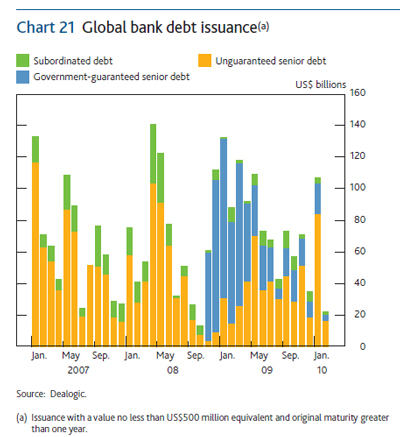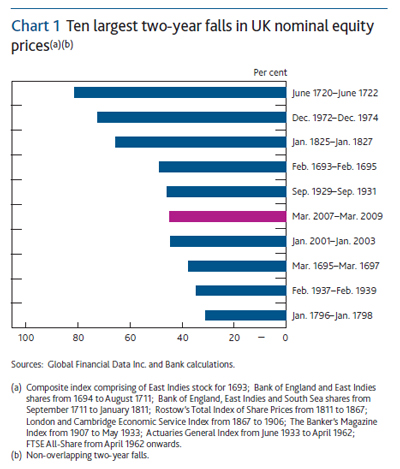The IMF has released the March 2010 edition of Finance & Development.
Europe will bail out Greece, if necessary:
Europe’s blueprint for a financial lifeline to Greece amounts to an unprecedented bet by finance ministers that they can avert a euro crisis by sidestepping the no-bailout rules intended to sustain the 11-year-old currency.
Improvising their way through the euro’s harshest test since its debut in 1999, officials meeting in Brussels late yesterday and today worked out a strategy for emergency loans in case Greece’s plan for 4.8 billion euros ($6.6 billion) in tax increases and wage cuts fails to stave off fiscal disaster.
There is no word as to whether the EU will demand management changes, vilify the top guys, claw back pay or threaten criminal charges. S&P affirmed Greece at BBB+.
Moody’s is shift municipal ratings to the global scale:
Municipal bond issuers led by California Treasurer Bill Lockyer began pressing companies that rate their debt two years ago to show investors how they would be rated on a corporate scale. They claimed that the scale cost them more in interest rates because state and local borrowers default at a lower rate than higher-rated corporations.
U.S. Representative Barney Frank, a Massachusetts Democrat who chairs the House Financial Services Committee, called the different rating scales “ridiculous” at a hearing on the $2.8 trillion market in May 2008.
This cosmetic change was last reported on PrefBlog in September 2008 in Global Scale for Municipal Credit Ratings a Bust?. So, the story so far is: CDOs, etc., must get their own scale because global scales are ridiculous. Municipalities must get their own scale because the global scale is ridiculous. Can’t tell your players without a political programme, can you?
In a speech at the Heyman Center on Corporate Governance, Julie Dickson acknowledged the issue of regulatory capture, but didn’t offer any insights:
Simon Johnson, a professor at MIT, says that the failure of supervisory judgement is often linked to regulatory capture. Regulatory capture refers to supervisors thinking like the industry they regulate because they either come from industry, or hope to work in the industry. In some cases there may be a belief that it is easier to just agree with industry rather than to fight their lobbying efforts. He has written many articles on this, which I read with great interest as they contribute to the debate around regulators, incentives, and judgement.
My own view is that clear mandates and accountabilities, independence, resources, and international assessment programs are key to getting the incentives right. I would also say that I have seen some very courageous supervisors in my time, and that sometimes people recruited from industry are even more demanding, having experienced first hand some of the dynamics within institutions. So this issue is rather complex.
There was an interesting and unusual note in today’s FOMC release:
Voting for the FOMC monetary policy action were: Ben S. Bernanke, Chairman; William C. Dudley, Vice Chairman; James Bullard; Elizabeth A. Duke; Donald L. Kohn; Sandra Pianalto; Eric S. Rosengren; Daniel K. Tarullo; and Kevin M. Warsh. Voting against the policy action was Thomas M. Hoenig, who believed that continuing to express the expectation of exceptionally low levels of the federal funds rate for an extended period was no longer warranted because it could lead to the buildup of financial imbalances and increase risks to longer-run macroeconomic and financial stability.
A good day in the Canadian preferred share market, with volume at above-average levels. Six issues traded more than 100,000 shares on the Toronto Exchange. PerpetualDiscounts gained 3bp and FixedResets were up 8bp, which took yields of the latter down to 3.47%, the second-lowest on record.
| HIMIPref™ Preferred Indices These values reflect the December 2008 revision of the HIMIPref™ Indices Values are provisional and are finalized monthly |
|||||||
| Index | Mean Current Yield (at bid) |
Median YTW |
Median Average Trading Value |
Median Mod Dur (YTW) |
Issues | Day’s Perf. | Index Value |
| Ratchet | 2.61 % | 2.73 % | 56,770 | 20.86 | 1 | 0.5116 % | 2,114.4 |
| FixedFloater | 5.08 % | 3.19 % | 44,629 | 19.94 | 1 | -0.4186 % | 3,112.6 |
| Floater | 1.92 % | 1.73 % | 45,612 | 23.24 | 4 | 0.4907 % | 2,399.5 |
| OpRet | 4.90 % | 1.67 % | 101,349 | 0.20 | 13 | -0.0984 % | 2,309.6 |
| SplitShare | 6.41 % | 6.54 % | 127,596 | 3.69 | 2 | 0.6449 % | 2,130.0 |
| Interest-Bearing | 0.00 % | 0.00 % | 0 | 0.00 | 0 | -0.0984 % | 2,111.9 |
| Perpetual-Premium | 5.89 % | 5.93 % | 123,387 | 5.83 | 7 | 0.0738 % | 1,889.8 |
| Perpetual-Discount | 5.90 % | 5.96 % | 173,616 | 13.96 | 71 | 0.0256 % | 1,790.4 |
| FixedReset | 5.36 % | 3.47 % | 343,275 | 3.69 | 43 | 0.0833 % | 2,202.0 |
| Performance Highlights | |||
| Issue | Index | Change | Notes |
| HSB.PR.D | Perpetual-Discount | -2.14 % | YTW SCENARIO Maturity Type : Limit Maturity Maturity Date : 2040-03-16 Maturity Price : 21.00 Evaluated at bid price : 21.00 Bid-YTW : 5.98 % |
| BAM.PR.J | OpRet | -1.92 % | YTW SCENARIO Maturity Type : Soft Maturity Maturity Date : 2018-03-30 Maturity Price : 25.00 Evaluated at bid price : 25.52 Bid-YTW : 5.08 % |
| POW.PR.D | Perpetual-Discount | -1.20 % | YTW SCENARIO Maturity Type : Limit Maturity Maturity Date : 2040-03-16 Maturity Price : 20.56 Evaluated at bid price : 20.56 Bid-YTW : 6.20 % |
| RY.PR.H | Perpetual-Discount | 1.02 % | YTW SCENARIO Maturity Type : Limit Maturity Maturity Date : 2040-03-16 Maturity Price : 24.54 Evaluated at bid price : 24.76 Bid-YTW : 5.76 % |
| BAM.PR.M | Perpetual-Discount | 1.03 % | YTW SCENARIO Maturity Type : Limit Maturity Maturity Date : 2040-03-16 Maturity Price : 17.63 Evaluated at bid price : 17.63 Bid-YTW : 6.77 % |
| BAM.PR.N | Perpetual-Discount | 1.03 % | YTW SCENARIO Maturity Type : Limit Maturity Maturity Date : 2040-03-16 Maturity Price : 17.58 Evaluated at bid price : 17.58 Bid-YTW : 6.79 % |
| Volume Highlights | |||
| Issue | Index | Shares Traded |
Notes |
| TD.PR.N | OpRet | 585,800 | National sold 35,000 to RBC at 26.09; then 11,400 to Desjardins at the same price; another 25,000 to RBC at 26.09, and another 24,600 to Desjardins at the same price; finally selling 12,500 to anonymous at 26.09 again RBC crossed 10,000 at 26.09; National crossed 125,000 at 26.04; RBC crossed 123,000 at 26.09. National then crossed two blocks of 50,000 each, one at 26.09, the other at 26.04, then sold 50,000 to RBC at 26.09 and crossed 50,000 at 26.04. Some day! YTW SCENARIO Maturity Type : Call Maturity Date : 2010-05-30 Maturity Price : 25.75 Evaluated at bid price : 26.04 Bid-YTW : 1.67 % |
| TRP.PR.B | FixedReset | 256,662 | Recent new issue. YTW SCENARIO Maturity Type : Limit Maturity Maturity Date : 2040-03-16 Maturity Price : 24.89 Evaluated at bid price : 24.94 Bid-YTW : 3.94 % |
| RY.PR.T | FixedReset | 153,800 | Desjardins bought 47,300 from National at 28.09, then sold 50,000 to CIBC at 28.12. TD sold 34,900 to CIBC at 28.12. YTW SCENARIO Maturity Type : Call Maturity Date : 2014-09-23 Maturity Price : 25.00 Evaluated at bid price : 28.07 Bid-YTW : 3.43 % |
| BMO.PR.O | FixedReset | 132,580 | Scotia crossed 15,000 at 28.30; Desjardins bought 48,000 from National at 28.45, then sold 48,500 to CIBC at 28.48. YTW SCENARIO Maturity Type : Call Maturity Date : 2014-06-24 Maturity Price : 25.00 Evaluated at bid price : 28.40 Bid-YTW : 3.23 % |
| CM.PR.L | FixedReset | 113,148 | Desjardins crossed 68,900 at 28.30; National crossed 35,000 at 28.35. YTW SCENARIO Maturity Type : Call Maturity Date : 2014-05-30 Maturity Price : 25.00 Evaluated at bid price : 28.30 Bid-YTW : 3.37 % |
| RY.PR.Y | FixedReset | 106,600 | Desjardins bought 37,900 from National at 28.10, then sold 40,000 to CIBC at 28.12. YTW SCENARIO Maturity Type : Call Maturity Date : 2014-12-24 Maturity Price : 25.00 Evaluated at bid price : 28.06 Bid-YTW : 3.44 % |
| There were 41 other index-included issues trading in excess of 10,000 shares. | |||

